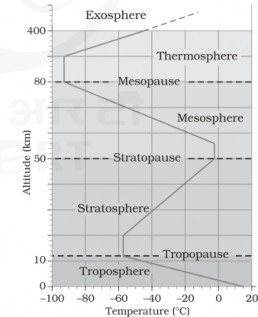2.1. Troposphere
Troposphere is the lowermost layer of the atmosphere. Its average height is 13 km and extends roughly to a height of 8 km near the poles and about 18 km at the equator. It is thickest at the equator because strong convection currents transport heat to such great heights. It contains 75 per cent of the total gaseous mass of the atmosphere. This layer contains dust particles and water vapour also. The temperature in this layer decreases at the rate of 1°C for every 165m of height (or at a mean rate of 6.5 degree C /km).The decrease occurs because air is compressible and its density decreases with height allowing rising air to expand and thereby cool. It is interesting to note that the lowest temperature in the entire troposphere is found over the equator and not at the poles. The air temperature at the top of troposphere is about minus 800C over the equator and about minus 450C over the poles.
Word ‘troposphere’ is derived from the Greek word ‘tropos’ meaning ‘mixing’. Troposphere is marked by turbulence and eddies. It is also called the convective region, for all the convective cease at the upper limit of the troposphere. All changes in climate and weather take place in this layer. Clouds formation, thunderstorms etc. occur in this layer. Wind velocity increase with height and attain the maximum at the top.
At the top of the troposphere there is a shallow layer separating it from the next thermal layer of the atmosphere. This shallow layer is known as the tropopause. Tropopause has its greatest height near the equator. In the middle and high latitudes, the height of the tropopause varies according to seasons. For example, at latitudes 45N&S the average height of the tropopause in January is about 12.5 km while in July it becomes 15 km.

